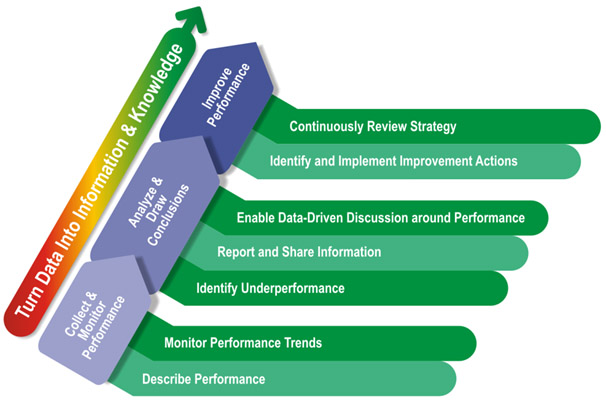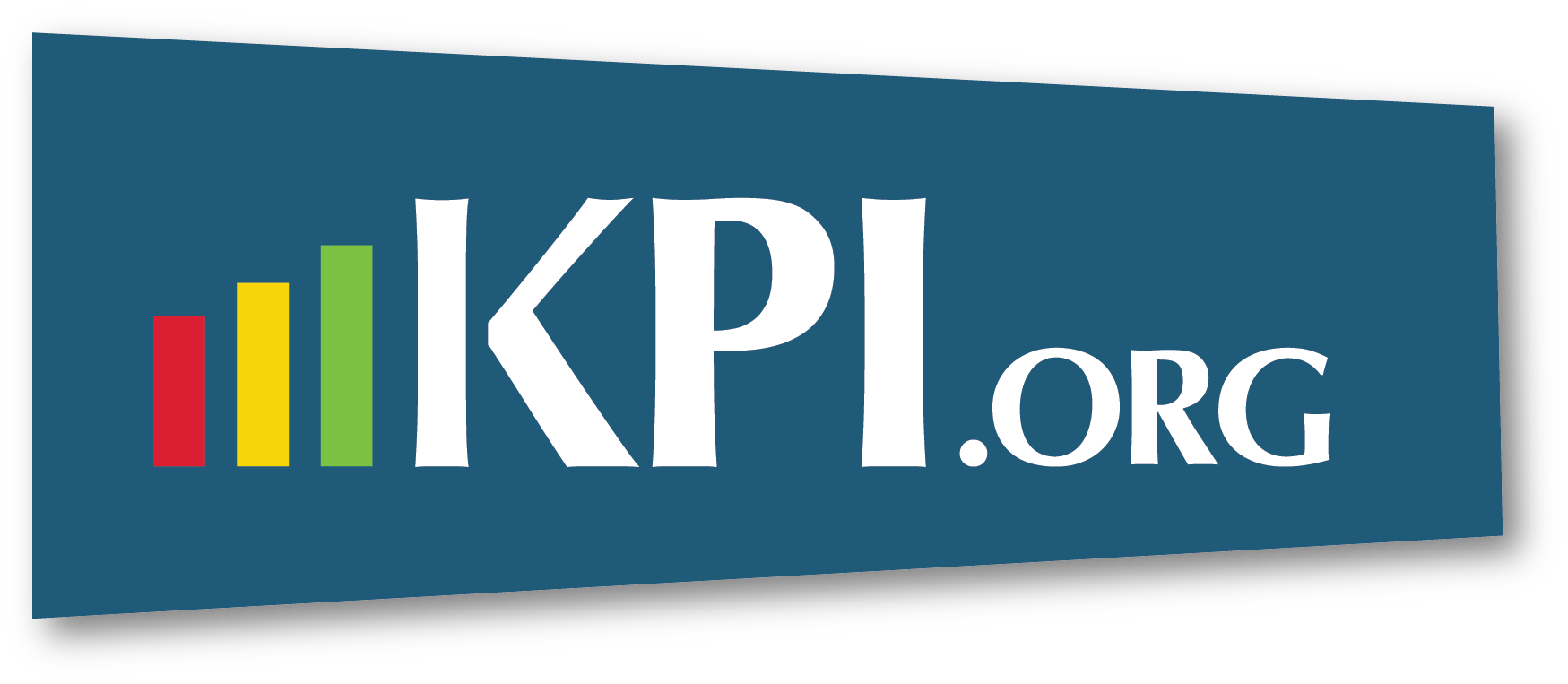Dashboarding And Analysis
Performance analysis transforms data into knowledge and understanding. Effective analysis helps people make better decisions that will drive improved strategic outcomes. This step focuses on measuring and evaluating performance to identify what works well and what doesn’t, taking corrective action and becoming a high-performance organization.
During this step, the team transitions from building a strategic management system to implementing one, pivoting from questions such as, “What are we going to measure?” and, “What are we trying to accomplish?” to questions such as:
- How are we performing?
- Which of our strategies is working?
- Why are some strategies working while others are not?
- Are we measuring the right things?
Choosing the right things to measure, setting up the performance measurement system, and creating a performance culture where performance information is used and acted upon is hard work. But the benefits of doing so can be significant to the organization.
Effective performance analysis means understanding how to interpret patterns and make meaningful comparisons. There’s not much knowledge in a single point of data or the wrong points of comparison. Many individuals and teams make decisions based solely on poor comparison choices, like percent change from a previous period or rolling averages. Truly understanding whether or not things are getting better requires a deeper dive into the numbers.
Performance analysis is about providing and using performance information to support decision-making in new and improved ways.
Performance analysis transforms data into knowledge and understanding. Effective analysis helps people make better decisions that will drive improved strategic outcomes. This step focuses on measuring and evaluating performance to identify what works well and what doesn’t, taking corrective action and becoming a high-performance organization.
During this step, the team transitions from building a strategic management system to implementing one, pivoting from questions such as, “What are we going to measure?” and, “What are we trying to accomplish?” to questions such as:
- How are we performing?
- Which of our strategies is working?
- Why are some strategies working while others are not?
- Are we measuring the right things?
Choosing the right things to measure, setting up the performance measurement system, and creating a performance culture where performance information is used and acted upon is hard work. But the benefits of doing so can be significant to the organization.
Effective performance analysis means understanding how to interpret patterns and make meaningful comparisons. There’s not much knowledge in a single point of data or the wrong points of comparison. Many individuals and teams make decisions based solely on poor comparison choices, like percent change from a previous period or rolling averages. Truly understanding whether or not things are getting better requires a deeper dive into the numbers.
Performance analysis is about providing and using performance information to support decision-making in new and improved ways.
The Performance Analysis process applies methods and measurement software to get the right information to the right people at the right time. Performance Analysis adds structure and discipline to strategic planning and management implementation and strategy execution and helps communicate performance information. Ultimately, effective performance analysis helps transform disparate corporate data into information and knowledge. Implementing an automation solution and managing ongoing performance analysis typically begins with a team, including the scorecard champions and key stakeholders in the information technology department and other functions. This team selects and implements the software, creates the scorecard structure, translates and imports the data into the system, and manages the data or assists assigned objective owners with that responsibility. The system champion maintains coherence and consistency and coordinates with the owners of the objective commentary. These owners maintain measures and initiatives and are ultimately responsible for ongoing refinement of performance measures.
The Performance Analysis Step has four components:
- Select the most appropriate automation tool
- Collect and monitor performance
- Analyze and draw conclusions
- Improve performance

1. Select the Most Appropriate Automation Tool
Effective automation makes it easier to consolidate, analyze, present, share and report data from anywhere. Discipline and efficiency are gained by having the group use one automated system to capture, compile, report and analyze data quickly and with few errors. Organizations that don’t select just one system can end up with several different home-grown systems that aren’t coordinated and may have difficulty communicating with each other. For example, an accounting manager might end up with a macro spreadsheet that no one else understands, leaving the entire design, maintenance and control dependent upon a single person. An enterprise-wide system gives everyone a common operating picture. It creates a governance structure for the living strategy and the management/planning process. Automation makes performance information easily accessible, so selecting options is faster and evidence-based.
2. Collect and Monitor Performance
Gathering and tracking data on the historic levels and current trends in performance encompasses more than just counting things and capturing data. Creating comparisons makes the data meaningful, enabling deeper interpretation and better decisions. This step answers many questions, including:
- What specific questions need to be answered?
- Are there specific decisions that require data to support?
- How often do decision-makers need updated information?
- Is there a broader purpose for the analysis?
- Are there unusual stakeholder interests that need to be taken into consideration?
- What is the logic of the strategy and the context of this measurement relative to others?
- Where does this measure fit in the bigger picture?
- Are there other related process or output measures?
Describe Performance
Describing current performance status at a specific time requires delving into the data deeply enough to truly understand what the data are telling the management team. It amounts to establishing a relatively complete understanding of performance in a meaningful way. In other words, if someone were to simply tell you that their favorite political candidate “won” an election, they would not be sharing enough detail for you to truly understand the situation or the level of performance. Was the candidate running for president of the country or the local school board? Did the candidate win by a landslide or were there recounts involved? Was the win expected or was it a historic upset? To truly understand the current level of performance relative to this statement, one would have to know the answers to each of these questions.
Monitor Performance Trends
Visualizing performance over time identifies trends that show data direction and development and provide context for the underlying story relative to strategy. The key to interpreting a measurement is comparison. For example, if the number of service errors in a month is 25, understanding whether 25 is good or bad requires answering the question, Compared to what?
Track performance against a carefully-designed performance target, as shown in or as part of a control chart, a tool showing the natural variation in performance data (Figure 12). These charts, also known as Shewhart or process-behavior charts, plot data against the mean and a set of control limits over time.
3. Analyze and Draw Conclusions
This step addresses the significance of good performance or underperformance. The team identifies underperformance and starts a dialogue about how, where, when and especially why any particular underperformance is happening. The group also seeks answers to important questions, such as, “Why did this trend occur?” “Is there cause to celebrate good news?” and “Why is performance different now?”.
Identify Underperformance
Underperformance is identified by comparing current performance to targets and thresholds or by looking for signals in the control chart, which indicate normal variation (noise) and exceptional variation (signal).
Report and Share Information
Reporting and sharing information is the first step toward making better decisions and acting on the information in a way that improves overall performance. This is why it’s important to have an automated system that everyone can log into and that has built-in visuals that are intuitive to use and easy to understand.
4. Improve Performance
The final step in the process is using performance data as an ongoing indication of whether or not actions taken are effective. Use one or more of the many process improvement tools available, such as process flow analysis or cause-effect analysis, to determine actions to improve performance. When strategic initiatives are in place that are designed to move the needle on these measures, the initiative owner’s job is to focus on implementation. Control charts monitor performance over time to determine if it’s truly improving based on the signals. After each objective and measure is evaluated, the organization is smarter about how it’s actually performing. The information and knowledge from this analysis should continuously feed the strategic planning cycle.
Identify and Implement Improvement Actions
Mark Twain is often quoted as having said “Data is like garbage. You’d better know what you are going to do with it before you collect it.” Managers don’t want to spend time and effort collecting data and then try to figure out what to do with it. The key is to:
- Evaluate the effect of each improvement action on an ongoing basis using the same principles and methods deployed in the earlier steps.
- Monitor performance data for the desired signals, long-term targets and thresholds that guide discussions.
- Maintain a continuous process improvement focus.
Continuously Review Strategy
Beyond driving decision making, performance analysis results feed back into the strategic planning loop. During the preceding steps, strategy was developed as a hypothesis. During this step and again in the evaluation step, strategic decisions start to become evidence-based. It is critical that any lessons learned during the performance analysis step become the basis for improved strategic decisions during the evaluation step.

